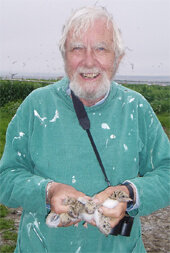Field problem presented: Peter Alden – Central and South American bird field guides
Ian Nisbet, NOC member since 1975, is an independent tern researcher who has been the primary monitor for the Roseate Tern and Common Tern colonies in Buzzard’s Bay, particularly at Bird Island.
Dr Nisbet was born in the UK and received his PhD in physics at Cambridge University in 1957. He moved to Massachusetts in 1968 and began studying Common and Roseate Terns in 1970. He was on the scientific staff of Massachusetts Audubon Society for several decades and was involved in the research that led to the gradual banning of the sale of chlorinated pesticides in the 1970s in this country.
Dr Nisbet and his wife Shirley reside in North Falmouth on Cape Cod.


I am trying to contact Ian Nesbit for various reasons, not least of which he is the last surviving member of the British Birds Rarities Committee, which is celebrating his 60th anniversary. If he was in U.K. It would be great if he could come to the Birdfair where a glass or two will be raised. If not then here is a tribute to him from afar.
Richard Porter (who was influenced by his visit to the Bosporus with Tom Smout in 1956).
you will find him still in Massachusetts if you Google him. I used to work with him in the 1970s and 80s in DC in an environmental consulting firm there. We later visited him in Mass but have lost touch.
I used learned that Dr. Ian C. T. Nisbet conducted ornithological research and bird ringing at Lista, Norway in 1953. Thereafter, he wrote an article together with David M Griffin, both of Cambridge Bird Club about their findings. They also explored the Fair Isle- Utsira route, previously indicated by Muster-Chaworth of the British Museum. I think it is so interesting to learn more about the international connections of knowledge-building in this field from the 1880s and onward.